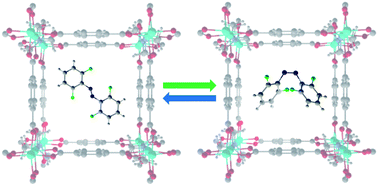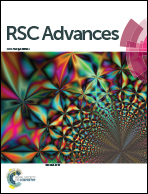Structural, dynamical, and photochemical properties of ortho-tetrafluoroazobenzene inside a flexible MOF under visible light irradiation†
Abstract
Considering porous materials as host matrices is an elegant way to enable photoswitching of non-covalently attached organic dyes even in the solid state. By focusing on the resulting optical properties as a function of loading degree and synthesis procedure, the occurring host–guest and guest–guest interactions can be determined and further exploited. In the course of this study, the photochromic behavior of ortho-tetrafluoroazobenzene (tF-AZB) inside flexible DMOF-1 was investigated from these points of view. It was found that depending on the loading degree and temperature, tF-AZB shows varying E/Z ratios and switching efficiency. For systems with low loading, reversible visible light induced isomerization was observed over ten switching cycles: Upon violet light exposure, formation of 100% E isomer was generated, while green light irradiation resulted in ∼60% Z-tF-AZB. Complementary molecular dynamics simulations at DFTB (density functional tight binding)-level revealed changing binding sites for Z-tF-AZB inside DMOF-1. For the E isomer, only low oscillations have been found, which in turn display a rare T-stacking interaction. Although the interaction strengths of the E and Z isomers with DMOF-1 are in the same range, the different mobility of both isomers due to varying binding sites explains the preference of the E isomer even upon green light exposure.



 Please wait while we load your content...
Please wait while we load your content...